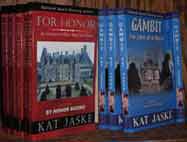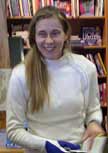
Can one woman save a
country? TWICE?
Can she do it as a lady musketeer and fencer in 17th-century France, AND
can she and the musketeers grant a hero's final wish?

Five-star reviewed book.
More Articles
Writing articles p1 - >>>
Writing
articles p2 - >>>
Edit your own writing - >>>
Personal budget - >>>
|
 Kat
Jaske has had several articles published in many web sites on the Internet.
Do a google search for creative fiction writing
workshop to find many of the sites. Or do a search on Kat
Jaske. Kat
Jaske has had several articles published in many web sites on the Internet.
Do a google search for creative fiction writing
workshop to find many of the sites. Or do a search on Kat
Jaske.


Article 5. Creative Fiction Writing Workshop: Creating
Your World for Your Story.
When writing a novel, the author must craft a convincing, interesting
story and create endearing or even dislikeable characters.
However, creating a credible world backdrop for the characters and the
story is just as crucial for writing a first-rate novel. Details
are more important than one might think!
Pay attention to these three things to create a credible world, and your
readers will return to visit again and again.
1) The world you craft must be believable. That
means if you are writing historical fiction set in seventeenth century
France, the historical details of the time period must be accurate and
consistent. The author will need to research such details as significant
historical events or personages, prevailing cultural attitudes and ideas,
the political atmosphere and events, types of food eaten, types of clothes
worn, manners of speech, and the list continues.
“Fast-paced music echoed through the hall. Violins,
cellos, violas and a plethora of other stringed instruments. Heads
turned as a new couple entered the festivities. He was tall, well-toned,
and darkly handsome. His partner was a tall, blond beauty sporting a light
blue dress with a somewhat fashionable décolleté.
It set off her skin tone and breathtaking figure perfectly, despite its
relative simplicity. There were whispers about the pair as they joined
the reel. Obviously nobles, but strangers
still.”
The above passage from For Honor by Kat Jaske is the result of extensive
research. What kind of music instruments did they play? What color
and style of dress would a noble woman wear? What type of dances would
they engage in?
“Finally she dropped in through the window of the second story,
and snatched the gun from her mouth, panting for breath. Her hands were
still shaking as she re-primed the gun and
searched for the servants’ entrance to Athos’ room, hoping
that he would not have thought to lock it. She had a bad feeling about
this. Really bad.
As she opened the servants’ entrance she heard the tell-tale spanning
of a wheel lock, and she propelled herself headlong into the chamber,
yelling, “Athos,” at the top of her lungs.”
The above descriptions of a gun are just enough to be interesting and
accurate. You must be sure your characters use a gun that would have existed
in the time period; else, it will stick out like a sour note to the savvy
reader who loves this genre of fiction.
2) Pay attention to the amount of detail in your
descriptions. Use details judiciously to enhance the reader’s
experience of the story and to help him/her imagine the world in which
he/she will be traveling. This means striking a delicate balance between
too little description of the world and too
much description. Either extreme is likely
to alienate your reader.
Remember, readers love the historical tidbits that enhance the story,
but when it turns into a tedious chore to keep everything straight, they
may close your book forever.
The way to learn proper balance is to do a lot a reading and see what
other good fiction writers have done and also practice creating a lot
of worlds. Then, get feedback from readers about what you have written.
3) Add in the elements that are fictional--those
that come out of the author’s own imagination-- in a way that these
elements do not seem to clash with the established atmosphere for the
story. Fictional aspects should mesh harmoniously with the realistic
aspects of the story. There are times an author can take greater liberty
with established facts, but a wise author, especially of historical fiction,
will acknowledge that he or she has taken some liberties.
For a fantasy world, there will be more fiction
involved and much more detail must be devoted to
establishing the rules of the world, the races, the technology, the geography,
the history of that world, etc. Be careful though. Characters should still
follow “rules of human behavior” or no reader will wish to
continue reading.
Remember, to have an outstanding story the world must support the cast
and the storyline and not detract from either. So detail, detail, detail--within
reason.
Buy books at big
discount->>>
Kat Jaske ©2006 All rights reserve.
Reviews <<<more
reviews ->>>
- "Best stories and best written books I
have read in several years."
Mark Myers - storyteller - Ohio
- Selected by Las Vegas Green Valley High School for the 2006 Reading
Incentive Program
More reviews ->>>
|

Article 6. Creative Fiction Writing Workshop: Creating
Your World for Your Historical Fiction Story
So you want to write an exceptional historical fiction novel? Of course,
you will need to dedicate a significant amount of time to the process
of crafting the story and developing both endearing and dislikeable characters.
But that’s not enough.
Even if you create a magnificent story and memorable characters, a poorly
created world will ruin the entire reading experience. For a truly first-rate
story, the historical fiction writer must devote
a tremendous amount of effort to creating a totally credible world
for the characters and the story. Too many or
too few details will make or break the story.
You must pay particular attention to the following things:
1) Make your historical world accurate
so that readers feel they have been transported back in time to the era
of the story. This means that you as an author of historical fiction have
your work cut out for you. You are going to have to do research on the
time period, the country or countries, and the city or cities where your
novel is set.
And you will need to do far more research than you think. In fact, you
will have to become an expert on your chosen time. Specifically, you will
have to know the major and sometimes minor historical and political events
of the country and the countries surrounding it.
You will have to research a few hundred years into the past to get a
feel for how the attitudes of the culture or the cultural practices were
shaped.
And still your work is not done. Seemingly inconsequential details about
types of language used, types of clothes worn depending on social status,
types of food eaten, methods of transportation, weapons most frequently
used and styles of music of the time cannot be left unattended.
2) Use the details you have
gleaned from your research judiciously.
Just because you have all the detail doesn’t mean you will write
it all. The goal is to enhance the reader’s experience of the story
and to help him/her imagine the world in which he/she will be traveling,
not to teach a history course. Strike a delicate balance between too little
description of the world and too much description because either extreme
will alienate your reader.
Avoid using too many esoteric words from the time period that your readers
may not understand. If you drown them in your knowledge, they will just
put aside your book and go on to something more interesting. Instead,
give them just a delightful flavor of the time period.
Unfortunately this means that you will
never put to paper the vast majority of what you researched,
but your expertise in manipulating the world will definitely show through
and entice your readers back for more.
In order to strike this delicate balance you must practice. And then practice
some more. Start writing small segments and then expand. Get feedback
from those you trust to give an honest opinion. Get feedback from several
sources. Then use that feedback to modify and improve your work.
3) Finally, add in purely fictional elements––things
that come out of the authorial imagination. Be careful that you add them
in a way that they do not clash with the world or with the characters
you have labored to create. Fictional aspects should mesh harmoniously
with the realistic aspects of the story.
There are times an author can take greater liberty with established facts,
but a wise author, will acknowledge that he or she has taken some liberties.
Read other good historical fiction to get ideas on how to accomplish this
blending.
Remember, in an interesting and successful story the world must support
the cast and the storyline and not detract from either. So detail, detail,
detail—but not too much or too little. It must be just right. Kat
Jaske www.forhonor.com ©2006 All rights reserved.
Kat Jaske is an English and French teacher in Las Vegas, where her high
school selected For Honor as the featured book for the 2006 Reading Incentive
Program.
Can one woman save a country? Can she do it as a lady musketeer and fencer
in 17th-century France, and can she and the musketeers grant a hero’s
final wish? This historical fiction novel is a great example of how to
write it right. See the author web site http://www.forhonor.com for more
information.
Author Kat Jaske is a sport fencer. Her books feature musketeers, fencing
and sword fighting, along with a wonderful human-interest story.

Righting Time
Book Three of BY HONOR BOUND
by Kat Jaske
What if Jala really
is from the future and the fate of her future does depend on convincing
Laurel and the 17th-century musketeers of that truth? Read
Excerpts
|